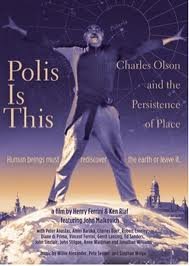| » Cover | ||
|
Essays
If M. C. Richards was the mystic soul, the Sophia, behind Black Mountain College's artistic pulse, Charles Olson was its force of nature, its tutelary deity. Both Richards and Olson transformed the way we think about craft, words, beauty, spirit, and the relationships artists perceive between the artist and the earth, and the artist and the human—but not only that, their programs as radical, difficult, and transformative as they could be—and in a way how nutty and awkward—aimed not at the scholar and the academic, but at Everyman. Ferrini and writer Ken Riaf's meditative documentary succeeds not only in conveying the gigantic power and immanence of Olson's poetics, but also the physical space taken up by Olson's 6-foot, 7-inch frame, and the earthiness—the landscape, historical and literal, of Olson's poetry and the mind behind it:
THESE DAYS Olson considered himself an archaeologist and projected himself, particularly through his unfinished magnum opus, The Maximus Poems, into the landscape of Gloucester, Massachusetts, where he lived during much of his childhood, and in his later life after Black Mountain College, until near the time of his death in 1970. The film opens with a close-up of an eye, and a female voice reciting lines from "Maximus to Gloucester, Letter 27" in which the poet's body compels Gloucester's geography to yield to the poet's Space—becoming one with it. The poem, closing with "Polis / is this", resonates back to "Polis is / eyes"—the first lines of "Letter 6" in which Olson commands the eye to see what is there—commends each reader to view the world without hierarchies, without infinity "there are only / eyes in all heads / to be looked out of." As the voice recites the viewer breathlessly flies over the landscape of Cape Ann and becomes Olson, inside the landscape, and is thus taken up into the film's multiple voices, democratic vistas. Ferinni, thus, boldly breaks the usual documentarian pattern of straightforward biography. Instead of a pedestrian summation of a career we're giving a careening impressionist view of the poet conjured from clips of Olson's shamanistic readings of his work; interviews with his son, fellow poets, artists, former students, and scholars including Robert Creeley, Jonathan Williams, Anne Waldman, Robin Blazer, Diane di Prima, Chuck Stein, Amiri Baraka, and Pete Seeger; gorgeous images of Cape Ann and the Gloucester harbor and historical images of town life; John Malkovich reciting from Olson's seminal work "Projective Verse;" numerous other voices reciting the work; and moving interviews with a local barber, waitress, and UPS driver. The UPS driver on being asked if he knew Olson replies, "The poet? The big guy?" and happily responds that as a child he appears in one of Olson's poems. The interviews with the locals persuasively impart Olson's inseparableness from the town—even though decades passed before the town understood how Olson and it had become one. Apparently, if I understand the film completely, the landscape now holds lovingly placed inscriptions of his words. Olson's polis is a place of contentment and preservation, natural evolution and nurture. Ferinni also shares excerpts from Olson's letters to the local newspaper as development threatened Gloucester's Edenic and traditional life. We come to understand that Olson's poetics actively engaged not only through expression in the word, but literally in the land and the culture of the town. Harvard Professor of Landscape History, John Stilgoe, quotes Olson on the landscape, while commenting on Olson's prismatic ability to illuminate the local: "I take SPACE to be the central fact to man born in America. I spell it large because it comes large here. Large and without mercy." Poet Susan Thackrey evokes Olson's role as Titan. Former student Michael Rumaker explains Olson's urgency to see what you see "from where you are." Former student Ed Sanders recalls how Olson could pull Shakespeare, or anything, "out of a drawer, like a spoon" his mind "was everything, absorbed everything." The film tells us that to the Greeks "polis" meant a community no larger than what you could walk its circumference in two days. Jonathan Williams once told me Olson told his class at Black Mountain College: "There are four legs to stand on. The first, be romantic. The second, be passionate. The third, be imaginative. And the fourth, never be rushed." Truly, that too, defines the polis Olson sought and the lost garden we all remember. Polis is This is a stunning film, remarkable for the way it absorbs the viewer into experience and vision, memorable for the beauty of its visuals and the way they become integral to the poet's words, notable for its revolutionary approach to literary biography, and a perfect and sublime a monument as one can imagine to Olson's Maximus.
|
|||||
